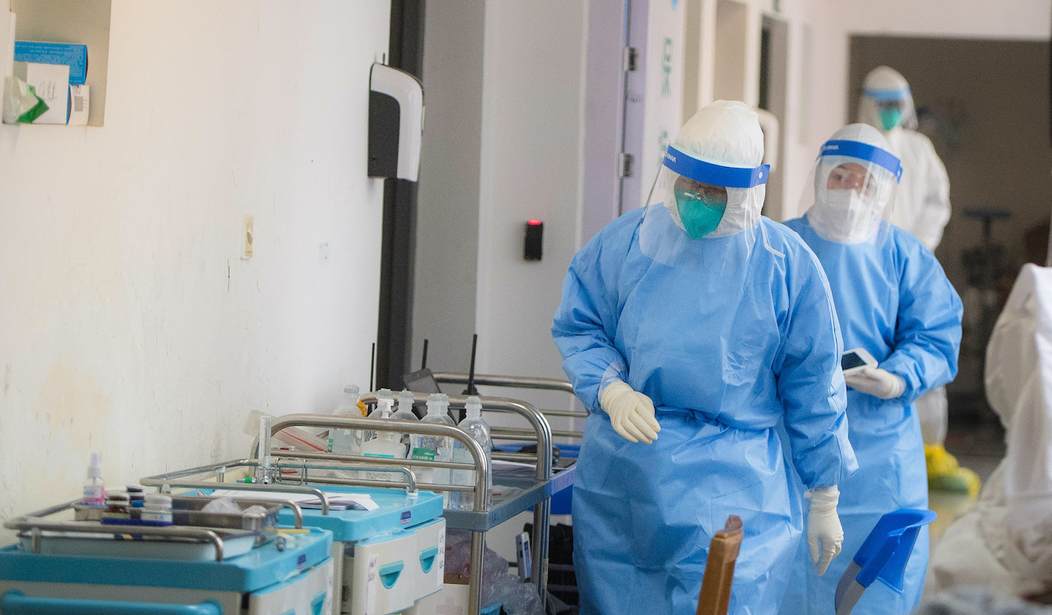A new report on COVID-19 origins suggests that SARS-CoV-2, the virus responsible for the COVID-19 infection, likely originated at a Wuhan wet market, despite the questionable source of the information used to compile the report. When I say you’ve got to read until the end, you’ve got to read until the end. This one should let you know just how bad things are when it comes to the COVID-19 origins investigations.
Dr. Michael Worobey is an evolutionary biologist and the Head of the Ecology and Evolutionary Biology Department at the University of Arizona. Early in the pandemic, Worobey appeared to be a very reliable source of sanity in the discussion of the COVID-19 origin, stating openly that there was not enough information to determine the origins of SARS-CoV-2, and that both the zoonotic event (that is, the jump from animals to humans) and the lab-leak from the Wuhan Institute of Virology, were both entirely possible potentials.
That all changed November 18th, when Worobey published the “findings” of his “investigation” into the origins in COVID-19. Those findings suggest that the virus likely originated from the wet market, a contention long-held by lab-leak opponents, despite no evidence of a host animal or identified intermediate species. In fact, this new report is filled with glaring holes and jumps in evidence and logic to reach certain conclusions. As the author identifies early cases of COVID-19, he goes into detail about two particular patients:
“Crucially, however, the now famous “earliest” COVID-19 case (1), a 41-year-old male accountant, who lived 30 km south of Huanan Market and had no connection to it—illness onset reported as 8 December—appears to have become ill with COVID-19 considerably later (12). When interviewed, he reported that his COVID-19 symptoms started with a fever on 16 December; the 8 December illness was a dental problem related to baby teeth retained into adulthood (12). This is corroborated by hospital records and a scientific paper that reports his COVID-19 onset date as 16 December and date of hospitalization as 22 December (13). This indicates that he was infected through community transmission after the virus had begun spreading from Huanan Market. He believed that he may have been infected in a hospital (presumably during his dental emergency) or on the subway during his commute; he had also traveled north of Huanan Market shortly before his symptoms began (12). His symptom onset came after multiple cases in workers at Huanan Market, making a female seafood vendor there the earliest known case, with illness onset 11 December (12). Notably, she reported knowledge of several possible COVID-19 cases in clinics and hospitals that were near Huanan Market from 11 December, and Huanan Market patients were hospitalized at Union Hospital as early as 10 December.” (emphasis added)
While the information contained in this part of the report seems to make sense, there appears to be a bit of revisionist history regarding this man’s original diagnosis. It has been accepted up until this point that this man’s original symptoms date back to December 8th, when they were first diagnosed. In Worobey’s explanation, he includes reports that suggest that these initial symptoms were related to a different issue, more specifically, a dental problem. Worobey ignores the fact that this man allegedly had symptoms before the 15th, was a patient at a Wuhan-area hospital before then, traveled on public transit, and had dozens of other public interactions. To accept Worobey’s explanation, we would have to assume that the wet market was the only way he could have been infected, which we know it wasn’t.
Additionally, this wet market vendor, whom he has identified as “patient zero,” clearly identified other patients around Wuhan that had been hospitalized before she became infected. How does Worobey genuinely make the “patient zero” claim knowing these statements of the supposed “patient zero?” But let’s just assume for argument’s sake that Worobey’s conclusion is questionable because of the information he used. How did Worobey acquire that information? Where did it come from that it had not before been included?
The answer? Chinese State-Controlled Media. The link he uses as the source for the accountant’s testimony sends us to “The Paper,” a Chinese language site with a video discussing information on the infections from the market. It is the comments, though, that should have immediately led Worobey to question the veracity of the content. Several of the comments suggest that the source of the virus was Trump and that Trump is a “paper tiger.” The video itself doesn’t suggest that the virus even started in China, simply that it was spreading at the wet market. The way that the video sounds suggests that the virus may have even come from abroad. Commenters agree, as numerous posts suggest that the US is the source of this virus and other viral pathogens.
Another source of Worobey’s origins “investigation?” The WHO report. Yes, the WHO report that only briefly examined the potential of a lab leak. Yes, the same WHO report that contained only information provided by the Chinese Government, absent any independent investigation or acquiring of evidence. Yes, the WHO report which was partially written by Peter Daszak, funder of some of the gain-of-function research conducted at the Wuhan Institute of Virology. And yes, the same WHO report that even the WHO has labeled as unreliable. It is so bad that the WHO has scrapped that whole report in favor of conducting an entirely new investigation.
This was known before Worobey even published this piece, yet Worobey included the report as a source to back up his findings. Nowhere in the study does he even acknowledge the WHO’s concerns with the veracity of the report, nor the acknowledged conflicts of interests for the data contained therein, including those of Peter Daszak.
But If you need another reason to distrust this report, I’ve got a few more to get to, including yet another tie to our old friend Mr. Daszak. When Worobey published his “investigation” in November, numerous MSM organizations picked up on the story, running this with headlines suggesting that this is the definitive start to this virus, even though the study doesn’t say the things they suggest it does. “Fresh look at earliest COVID cases points to live-animal market as most likely source,” says the LA Times. Fresh look? All the data in this entire study is over a year old and from the very sources that have the most to lose if a lab leak origin is confirmed. This is just a regurgitation of Chinese propaganda.
“First Known COVID Case Was Vendor at Wuhan Market, Scientist Says,” reads the New York Times. No. That’s not what the report says. The vendor herself pointed to COVID cases at numerous clinics around Wuhan suggesting there are more patients before her. How can patient zero be aware of previously hospitalized patients? Would that not justify further investigation? Yet, Worobey simply calls this patient zero and moves on.
Even the source of the vast majority of COVID lies, Peter Daszak, couldn’t sit this one out, acting as a source on the New York Times article:
“But Peter Daszak, a disease ecologist at EcoHealth Alliance who was part of the W.H.O. team, said that he was convinced by Dr. Worobey’s analysis that they had been wrong.
“That December the eighth date was a mistake,” Dr. Daszak said.
The W.H.O. team never asked the accountant the date his symptoms began, he said. Instead, they were given the Dec. 8 date by doctors from Hubei Xinhua Hospital, who handled other early cases but did not care for Mr. Chen. “So the mistake lies there,” Dr. Daszak said.
For the W.H.O. experts, Dr. Daszak said, the interview was a dead end: The accountant had no apparent links to an animal market, lab or a mass gathering. He told them he liked spending time on the internet and jogging, and he did not travel much. “He was as vanilla as you could get,” Dr. Daszak said.
Had the team identified the seafood vendor as the first known case, Dr. Daszak said, it would have more aggressively pursued questions like what stall she worked in and where her products came from.”
The point is that Worobey’s analysis never contradicted or corrected the WHO, only that it provided clarity. The WHO report had already identified the market vendor, who had a case that predated the accountant. The WHO team had contact with that vendor as well but did not ask additional questions as they felt she wasn’t patient zero. But even then, by this study’s admission, there are likely previous cases that they have not yet identified.
There’s even evidence to suggest that this virus may have been circulating in Wuhan as far back as September or October. In this study, Worobey admits there were two different lineages of the virus circulating in Wuhan in December 2019. Worobey makes an unbelievable jump and claims that these two different lineages were from two separate zoonotic events at two different markets, at the same time. You heard that right. He is arguing that two separate natural zoonotic events occurred at two different locations in Wuhan initially spreading two slightly different variants of the virus. What might be an easier explanation? A much earlier outbreak, with time for the viruses to mutate into two different lineages from two different pools of the infected. The problem with that is that an earlier outbreak likely leads right back to the lab. In fact, before the December super-spreader even at the Wuhan Market, there are no other ties to cases at the Wuhan Wet Market. If this vendor isn’t patient zero, the wet market theory dies right there.
The MSM and Worobey consider this to be a peer-reviewed paper, and in some ways, that may be true. It is the fact that those same peers also drafted papers suggesting that this virus came from the markets, and therefore lack any impartiality in their reviews of the paper. One of the papers suggesting a natural origin lists several of Worobey’s reviewers as authors alongside numerous authors of the Lancet Letter, which rejected the lab-leak theory before anything was even known about this virus. Another of Worobey’s reviewers is Kristian Andersen, who was the author of an email sent to Anthony Fauci, questioning the potential that the SARS-CoV-2 virus was genetically engineered. Curiously, despite Fauci’s emails containing almost exclusively email responses, Fauci tells Andersen that they will talk on a call. What could Fauci have possibly needed to tell Andersen that couldn’t have been emailed?
So what is the point of all this? Yes, Worobey’s conclusions could be correct, but that would require an enormous amount of luck and coincidence, neither of which is scientific in the slightest. Worobey presents information as if it is the totality of possibility in these cases, thus eliminating other equally likely potentials in the process. If this market vendor isn’t the first case, which it appears it is not, then the wet market theory ends. There are no other cases known to have originated at the market before then. Ignoring the potential that the wet market was not the origination point, but was simply a super spreading event, denies the factual potential of other origins. This paper is simply a regurgitation of other previous information, just organized in a different way. Think, reorganizing deck chairs on the Titanic. Sure, the presentation is different, but it in no way changes the fact that the ship is going down.
I reached out to Worobey to ask additional questions about his study, but at the time of writing this, nearly a week and a half after my attempted contact, he did not respond to me. While it really shouldn’t matter though, I think everyone should also be aware of who funds Dr. Worobey’s research.

Yes, that Bill and Melinda Gates Foundation. The same one that was funding viral research at the Wuhan Institute of Virology.













Join the conversation as a VIP Member